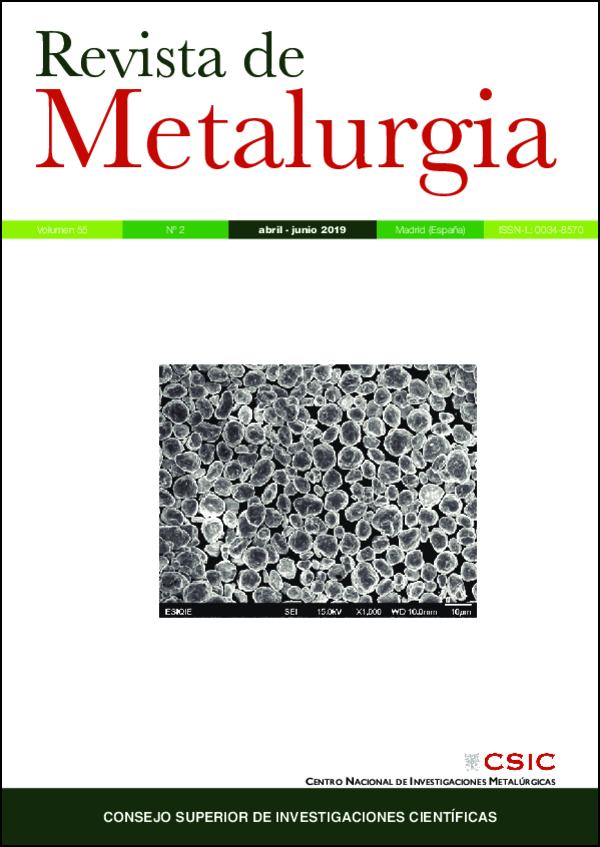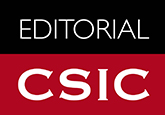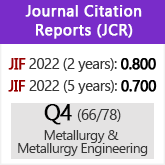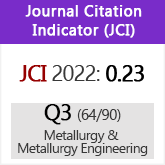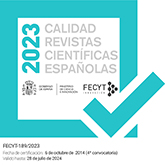Study of phase decomposition during spark plasma sintering of Al-5% Ni3Al composites
DOI:
https://doi.org/10.3989/revmetalm.145Keywords:
Composites, Diffusion, Interface, Mechanical alloying, Nanoindentation, Spark Plasma SinteringAbstract
The synthesis of Al-matrix composites reinforced with nanocrystalline intermetallic particles of Ni3Al was carried out with the Spark Plasma Sintering (SPS) technique. The Al-5%Ni3Al powder mixture was sintered by SPS at two different conditions: (i) 450 °C, 47 MPa and 180 s (4M47) and (ii) 520 °C, 16 MPa and 600 s (5M16). The Ni3Al particles were obtained by mechanical alloying after a milling time of 1260 ks. The composites show partial decomposition on the Ni3Al-Al interface, with the formation of the Al3Ni and Ni2Al3 phases. The analysis by TEM confirms the nanometric characteristics of the Ni3Al particles in the composites. The sintered composites 4M47 and 5M16 presented 95% and 87% of the theoretical density and Vickers microhardness values of 62.3±7 and 55.3±5 HV respectively. Nanoindentation tests show that the mechanical properties of the Al3Ni, Al3Ni2 and Ni3Al intermetallics are higher in high-pressure sintering conditions.
Downloads
References
Abbasi, M., Azadbeh, M., Sajjadi, S. (2010). Evolution of manufacturing parameters in Al/Ni3Al composite powder formation using blending and mechanical milling processes. J. Mater. Sci. 45 (16), 4524-4531. https://doi.org/10.1007/s10853-010-4548-7
Antolak-Dudka, A., Krasnowski, M., Kulik, M. (2013). Nanocrystalline Ni3Al produced by hot-pressing consolidation of mechanically alloyed powders. Intermetallics 42, 41-44. https://doi.org/10.1016/j.intermet.2013.05.014
Campo, M., Rams, J., Ureña, A. (2005). Determinación mediante nanoindentación de las propiedades mecánicas de la interfaz en materiales compuestos de aluminio reforzados con partículas de SiC recubiertas de sílice. Bol. Soc. Esp. Ceram. V. 44 (5), 270-277. https://doi.org/10.3989/cyv.2005.v44.i5.347
Cao, G., Geng, L., Zheng, Z., Naka, M. (2007). The oxidation of nanocrystalline Ni3Al fabricated by mechanical alloying and spark plasma sintering. Intermetallics 15 (12), 1672-1677. https://doi.org/10.1016/j.intermet.2007.07.003
Chen, C.-L., Richter, A., Thomson, R. (2009). Mechanical properties of intermetallic phases in multi-component Al-Si alloys using nanoindentation. Intermetallics 17 (8), 634-641. https://doi.org/10.1016/j.intermet.2009.02.003
Díaz, C., González-Carrasco, J.L., Caruana, G., Lieblich, M. (1996). Ni3Al Intermetallic particles as wear-resistant reinforcement for Al-Base composites processed by powder metallurgy. Metall. Mater. Trans. A 27 (10), 3259-3266. https://doi.org/10.1007/BF02663876
Enayati, M.H., Sadeghian, Z., Salehi, M., Saidi, A. (2004). The effect of milling parameters on the synthesis of Ni3Al intermetallic compound by mechanical alloying. Mat. Sci. Eng. A 375-377, 809-811. https://doi.org/10.1016/j.msea.2003.10.060
Eskin, Dm.G., Toropova, L.S. (1994). Tensile and elastic properties of deformed heterogeneous aluminum alloys at room and elevated temperatures. Mat. Sci. Eng. A 183 (1-2), L1-L4. https://doi.org/10.1016/0921-5093(94)90913-X
Fang, Q., Kang, Z., Gan, Y., Long, Y. (2015). Microstructures and mechanical properties of spark plasma sintered Cu-Cr composites prepared by mechanical milling and alloying. Mater. Design 88, 8-15. https://doi.org/10.1016/j.matdes.2015.08.127
Gan, B., Murakami, H., Maa, R., Meza, L., Greer, J., Ohmura, T., Tin, S. (2012). Nanoindentation and Nano-Compresion Testing of Ni3Al Precipitates. Superalloys 2012, 83-91. https://doi.org/10.7449/2012/Superalloys_2012_83_91
Hernández, P., Dorantes Rosales, H., Hernández, F., Esquivel, R., Rivas, D., López, V. (2014). Synthesis and microstructural characterization of Al-Ni3Al composites fabricated by press-sintering and shock-compaction. Adv. Powder Technol. 25 (1), 255-260. https://doi.org/10.1016/j.apt.2013.04.011
Hungría, T., Galy, J., Castro, A. (2009). Spark Plasma Sintering as a Useful Technique to the Nanostructuration of Piezo-Ferroelectric Materials. Adv. Eng. Mater. 11 (8), 615-631. https://doi.org/10.1002/adem.200900052
ICDD (2003). PDF-2/Inorganics 2003 (Database). Edited by Dr. Soorya Kabekkodu, International Centre for Diffraction Data, Newtown Square, PA, USA.
Li, X., Zhang, M., Zheng, D., Cao, T., Chen, J., Qu, S. (2015). The oxidation behavior of the WC-10 wt% Ni3Al composites fabricated by spark plasma sintering. J. Alloy Compd. 629, 148-154. https://doi.org/10.1016/j.jallcom.2015.01.010
Lieblich, M., González-Carrasco, J., Caruana, G. (1997). Thermal stability of an Al/Ni3Al composite processed by powder metallurgy. Intermetallics 5 (7), 515-524. https://doi.org/10.1016/S0966-9795(97)00027-7
Liming, K., Huang, C., Xing, L., Huang, K. (2010). Al-Ni intermetallic composites produced in situ by friction stir processing. J. Alloy Compd. 503 (2), 494-499. https://doi.org/10.1016/j.jallcom.2010.05.040
Meza, J.M., Franco, E.E., Farias, M.C.M., Buiochi, F., Souza, R.M., Cruz, J. (2008). Medición del módulo de elasticidad en materiales de ingeniería utilizando la técnica de nanoindentación instrumentada y de ultrasonido. Rev. Metal. 44 (1), 52-65. https://doi.org/10.3989/revmetalm.2008.v44.i1.95
Miranda, G., Madeira, S., Silva, F.S., Carvalho, O. (2017). A nanoindentation study on Al3Ni interface of Ni reinforced aluminum-silicon composite. Mech. Adv. Mater. Struc. 24 (10), 871-874. https://doi.org/10.1080/15376494.2016.1196790
Munir, Z.A., Anselmi-Tamburini, U., Ohyanagi, M. (2006). The effect of electric field and pressure on the synthesis and consolidation of materials: A review of the spark plasma sintering method. J. Mater. Sci. 41 (3), 763-777. https://doi.org/10.1007/s10853-006-6555-2
Muñoz-Morris, M., Rexach, J., Lieblich, M. (2005). Comparative study of Al-TiAl composites with different intermetallic volume fractions and particle sizes. Intermetallics 13 (2), 141-149. https://doi.org/10.1016/j.intermet.2004.07.033
Mussert, K., Vellinga, W., Bakker , A., Van Der Zwagg, S. (2002). A nano-indentation study on the mechanical behaviour of the matrix material in an A AA60691-Al2O3 MMC. J. Mater. Sci. 37 (4), 789-794. https://doi.org/10.1023/A:1013896032331
O'Donnell, G., Looney, L. (2001). Production of aluminium matrix composite using conventional PM technology. Mat. Sci. Eng. A 303 (1-2), 292-301. https://doi.org/10.1016/S0921-5093(00)01942-0
Oliver, W., Pharr, G. (2004). Measurement of hardness and elastic modulus by instrumented indentation: Advances in understanding and refinements to methodology. J. Mater. Res. 19 (1), 3-20. https://doi.org/10.1557/jmr.2004.19.1.3
Saheb, N., Iqbal, Z., Khalil, A., Saeed Hakeem, A., Al Aqeeli, N., Laoui, T., Kirchner, R. (2012). Spark Plasma Sintering of Metals and Metal Matrix Nanocomposites: A Review. J. Nanomater. 2012, ID 983470, 13 pages. https://doi.org/10.1155/2012/983470
Saheb, N., Khan, M.S., Hakeem, A.S. (2015). Effect of Processing on Mechanically Alloyed and Spark Plasma Sintered Al-Al2O3 Nanocomposites. J. Nanomater. 2015, Article ID 609824, 13 pages. https://doi.org/10.1155/2015/609824
Sajjadi, S., Abbasi, M., Azadbeh, M. (2011). Evaluation of the Characteristics of Interfacial Phases Produced in Al/Ni3Al Composite during Manufacturing. MSA 2 (9), 1340-1348. https://doi.org/10.4236/msa.2011.29182
Sameezadeh, M., Emamy, M., Farhngi, H. (2016). Effect of MoSi2 distribution on room and high temperature mechanical properties of aluminum matrix composites. J. Mater. Res. 31 (12), 1741-1747. https://doi.org/10.1557/jmr.2016.190
Seymour, R., Hemeryck, A., Nomura, K., Wang, W., Kalia, R.K., Nakano, A., Vashishta, P. (2014). Nanoindentation of NiAl and Ni3Al crystals on (100), (110), and (111) surfaces: A molecular dynamics study. Appl. Phys. Lett. 104 (14), 141904. https://doi.org/10.1063/1.4867168
Suryanarayana, C., Norton, M. (1998). Determination of Crystallite Size and Lattice Strain. In X-ray Diffraction: A Practical Approach, Springer USA, pp. 207-221. https://doi.org/10.1007/978-1-4899-0148-4_9
Torralba, J.M., Velasco, F., Costa, C.E., Vergara, I., Cáceres, D. (2002). Mechanical behavior of the interphase between matrix and reinforcement of Al 2014 matrix composites reinforced with (Ni3Al)p. Compos Part A Appl. Sci. Manuf. 33 (3), 427-434. https://doi.org/10.1016/S1359-835X(01)00104-X
Torralba, J.M., Campos, M. (2014). Toward high performance in Powder Metallurgy. Rev. Metal. 50 (2), e017. https://doi.org/10.3989/revmetalm.017
Torres, B., Lieblich, M., García-Escorial, A. (2006). Effect of heat treatments at 520 °C on aluminium alloy matrix composite reinforced with Ni3Al powder particles. Scripta Mater. 54 (8), 1485-1489. https://doi.org/10.1016/j.scriptamat.2005.12.052
Ureña, A., Rams, J., Campo, M., Sánchez, M. (2005). Aplicación de la nanoindentación para la determinación de las propiedades mecánicas interfaciales compuestos de matriz de aluminio. Rev. Metal. 41 (Vol. Extr.), 395-400. https://doi.org/10.3989/revmetalm.2005.v41.iExtra.1063
Wang, Y., Rainforth, W.M., Jones, H., Lieblich, M. (2001). Dry wear behavior and its relation to microstructure of novel 6092 aluminium alloy-Ni3Al powder metallurgy composite. Wear 251 (1-2), 1421-1432. https://doi.org/10.1016/S0043-1648(01)00783-9
Xue, Y., Shen, R., Ni, S., Song, M., Xiao, D. (2015). Fabrication, microstructure and mechanical properties of Al-Fe intermetallic particle reinforced Al-based composites. J. Alloys Compd. 618, 537-544. https://doi.org/10.1016/j.jallcom.2014.09.009
Yu, Y., Zhou, J., Chen, J., Zhou, H., Guo, C., Guo, B. (2010). Synthesis of nanocrystalline Ni3Al by mechanical alloying and its microstructural characterization. J. Alloys Compd. 498 (1), 107-112. https://doi.org/10.1016/j.jallcom.2010.03.123
Zhang, D.L. (2004). Processing of advanced materials using high-energy mechanical milling. Prog. Mater. Sci. 49 (3-4), 537-560. https://doi.org/10.1016/S0079-6425(03)00034-3
Published
How to Cite
Issue
Section
License
Copyright (c) 2019 Consejo Superior de Investigaciones Científicas (CSIC)

This work is licensed under a Creative Commons Attribution 4.0 International License.
© CSIC. Manuscripts published in both the printed and online versions of this Journal are the property of Consejo Superior de Investigaciones Científicas, and quoting this source is a requirement for any partial or full reproduction.All contents of this electronic edition, except where otherwise noted, are distributed under a “Creative Commons Attribution 4.0 International” (CC BY 4.0) License. You may read here the basic information and the legal text of the license. The indication of the CC BY 4.0 License must be expressly stated in this way when necessary.
Self-archiving in repositories, personal webpages or similar, of any version other than the published by the Editor, is not allowed.
